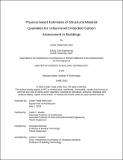| dc.contributor.advisor | Mueller, Caitlin T. | |
| dc.contributor.advisor | Reinhart, Christoph | |
| dc.contributor.author | Sory, Leïlah Yadia Kelly | |
| dc.date.accessioned | 2023-07-31T20:00:29Z | |
| dc.date.available | 2023-07-31T20:00:29Z | |
| dc.date.issued | 2023-06 | |
| dc.date.submitted | 2023-07-13T21:33:42.297Z | |
| dc.identifier.uri | https://hdl.handle.net/1721.1/151703 | |
| dc.description.abstract | Decarbonizing the built environment requires immediate actions to meet global climate targets. The world population growth and rapid urbanization rate add to the urgency of this challenge. In fact, buildings account for about 40% of all energy and carbon emissions from operations and materials’ production and construction processes. More specifically, buildings’ structural systems are responsible for a significant share of the upfront embodied carbon emissions before construction. Most LCA tools focus on fully detailed material takeoffs from high-resolution Building Information Models (BIM) and are therefore incomplete during conceptual design. Moreover, Urban building energy modeling (UBEM) is a proven technique allowing cities to evaluate technology pathways to achieve their net-zero emissions goals. It involves simplified building archetypes to estimate operational energy on a large scale with reasonable accuracy. However, little attention has been paid to urban-level embodied carbon assessment.
Therefore, this thesis investigates the potential of implementing physics-based structural quantities estimation in early-stage design for embodied carbon quantification at the urban scale. This approach combines bottom-up engineering calculations with data-driven surrogate modeling to automatically predict embodied carbon from a high-fidelity model. Finally, structural parameters are defined into energy model archetypes to deploy this method into an existing urban scale modeling tool. The feasibility of the proposed methodology is assessed through case studies to estimate embodied carbon and energy use intensities at the individual-building and urban scales. Results show the benefits of spatially mapping the distribution of embodied and operational carbon in the building stock and obtaining more nuanced estimates of carbon emissions compared with existing benchmarking studies. The primary use case of this work is to better inform planning and policy decision-making for retrofitting strategies and future building design. | |
| dc.publisher | Massachusetts Institute of Technology | |
| dc.rights | In Copyright - Educational Use Permitted | |
| dc.rights | Copyright retained by author(s) | |
| dc.rights.uri | https://rightsstatements.org/page/InC-EDU/1.0/ | |
| dc.title | Physics-based Estimates of Structural Material Quantities for Urban-level Embodied Carbon Assessment in Buildings | |
| dc.type | Thesis | |
| dc.description.degree | S.M. | |
| dc.contributor.department | Massachusetts Institute of Technology. Department of Architecture | |
| mit.thesis.degree | Master | |
| thesis.degree.name | Master of Science in Building Technology | |
